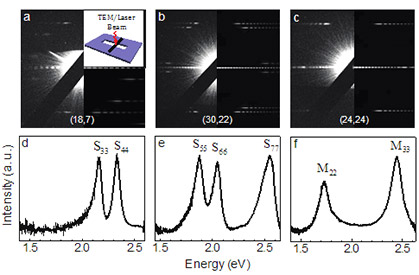
An international team of scientists headed by Feng Wang of the Materials Science Division of Berkeley Lab and Enge Wang of the International Center for Quantum Materials in Beijing, has mapped out an “atlas” of key structural and optical properties of carbon nanotubes. By painstakingly measuring both electron diffraction and optical scattering for hundreds of samples, the team created a reference to accelerate future nanotube studies for fundamental physics research as well as optoelectronic and photonic applications.
For electrons confined to nanotubes, the effects of quantum mechanics are amplified, making nanotubes a unique test-bed for studies of electron-electron interactions in one-dimensional systems. Wang’s team moved to accelerate such studies by reducing the number of measurements needed to determine the basic structural and optical properties of a given nanotube.
Working with the Molecular Foundry’s Shaul Aloni, the researchers performed both electron diffraction and optical scattering experiments on individual single-walled carbon nanotubes. They leveraged a one-to-one correspondence between nanotube structure and optical resonance to build a reference table covering hundreds nanotube variations. In the process, they also observed some of the exotic physics of confined electrons, marking the beginning of a systematic study enabled by their nanotube atlas.

